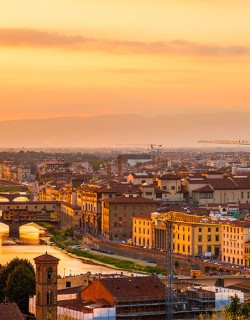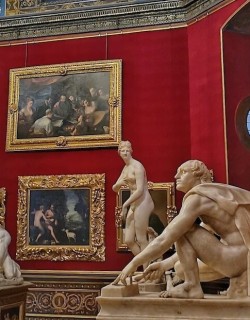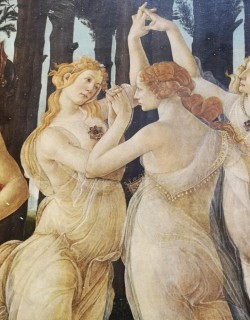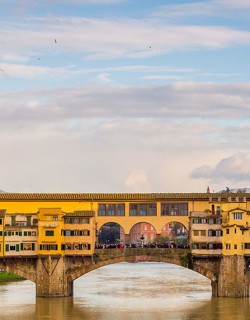A few steps away from the Fountain of Neptune in Piazza della Signoria is a plaque, marking the spot where three friars were hanged and burned in 1498. Walking through the beautiful city centre of Florence, it’s difficult to imagine that the piazza was once the scene of such horrors, but in fifteenth century Florence, execution was commonplace. Some of the crowd that gathered to watch the execution of the friars may have remembered the mass executions that took place in the same piazza twenty years earlier, when the Pazzi conspirators were tortured and hanged.
One of the friars who died in Piazza della Signoria, Girolamo Savonarola, was the most notorious preacher of the fifteenth century, loved and despised in equal measure. At the time of his death he had been condemned as a heretic, but he still had his followers. The profound influence of this charismatic, fanatical preacher had transformed Florence, and would last long after his death.
Savonarola was born in Ferrara in 1452. He was a solitary child, an obsessive reader who preferred studying Thomas Aquinas to spending time with friends. At the age of nineteen he was spurned by the woman he loved, and shortly afterwards he decided to abandon his medical studies and become a monk. He entered the Dominican order and spent several years in Bologna, where he became increasingly pessimistic, convinced of the world’s wickedness. He believed that corruption was everywhere, and that divine revenge was imminent.
In 1482 he moved to Florence, which was then under the rule of Lorenzo de’ Medici. He was horrified by the lack of religion and morality in the city, and disappointed by his initial lack of success as a preacher. After some apocalyptic visions he changed his style of preaching, and began to terrify his congregation with his prophecies. Savonarola took pride in preaching “a terrible sermon”, attracting increasingly large crowds at the church of San Marco. He also started to publish his writing, which helped to further his influence.
Due to his oratorical skills and his popular style of preaching, which involved descriptions of apocalyptic visions and supernatural voices, Savonarola became increasingly influential in Florence. He managed to obtain a papal brief that emancipated the Dominican order of San Marco, effectively making Savonarola an independent authority in Florence. He then consolidated his spiritual leadership after his dealings with King Charles VIII of France, ending the political turmoil and becoming the saviour of the city. His sermons began to take a more positive tone:
“I announce this good news to the city, that Florence will be more glorious, richer, more powerful than she has ever been; First, glorious in the sight of God as well as of men: and you, O Florence will be the reformation of all Italy, and from here the renewal will begin and spread everywhere, because this is the navel of Italy. Your counsels will reform all by the light and grace that God will give you. Second, O Florence, you will have innumerable riches, and God will multiply all things for you. Third, you will spread your empire, and thus you will have power temporal and spiritual.”
Under Savonarola’s rule, Florence became a very different city. He undoubtedly had a positive impact on some aspects of city life, feeding the starving, creating work for the unemployed and reducing taxes for the poor. The atmosphere in the city centre changed beyond recognition, as hedonism was replaced by asceticism, with Florentines singing hymns and joining convents while renouncing worldly pleasures. New rules were passed against immoral sexual behaviour and immodest dress, while a group of children formed a kind of morality army, collecting objects to be burned.
The famous “bonfire of the vanities” of 1497 is the perfect symbol of Savonarola’s extremist influence. Instead of the usual carnival celebrations, he encouraged the people of Florence to burn “sinful” objects such as make-up, mirrors, playing cards, books and musical instruments. One of Savonarola’s supporters was the great artist Botticelli, who allegedly agreed to burn some of his own paintings in the bonfire. Botticelli’s most famous surviving paintings can be seen on an Uffizi tour.
Inevitably, this combination of religious extremism and dangerous popularity meant that Savonarola had many enemies. His behaviour alarmed the Pope, who invited and then ordered Savonarola to come to Rome. Savonarola ignored the Pope and continued to preach in Tuscany. The Pope tried to prevent Savonarola from preaching, and then threatened him with excommunication, but nothing would stop the preacher from spreading his apocalyptic sermons.
A rival preacher challenged Savonarola to prove his divine mission by performing a miracle. Savonarola was supposed to walk through fire in Piazza della Signoria, and an expectant crowd gathered to watch, eager to find out whose side God would take. However, the contestants kept delaying and the event soon descended into chaos, with some people arguing that the fire walk should not take place, and others becoming angry and impatient. In the end a sudden downpour brought the day to an anticlimactic end, soaking the spectators. The rain was interpreted as a sign that God was against the event taking place, and Savonarola was left to face an angry mob.
Shortly afterwards, Savonarola was arrested and imprisoned in Palazzo Vecchio, along with two other friars who had been involved in the fiasco. Savonarola was charged with heresy and false prophecy, and during several weeks of torture he confessed to having invented his prophecies. He then recanted, and then confessed again.
On 23 May 1498, the three friars were led to the scaffold that had been constructed in Piazza della Signoria. They were hanged and burned in the same spot where Savonarola had once burned books during his bonfire of the vanities.
Many Florentines watching the burning bodies of the friars may have believed they deserved their fate, but Savonarola still had his supporters. Despite attempts by the Pope and the government to suppress his teachings and erase his memory, many people in Florence continued to venerate Savonarola and read his writing, in part thanks to the effort of the surviving friars of San Marco. Savonarola’s influence spread beyond Florence, as a surprising source of inspiration for Martin Luther, and even twentieth century political groups such as the Italian Christian Democratic Party.
~by Alexandra Turney~



